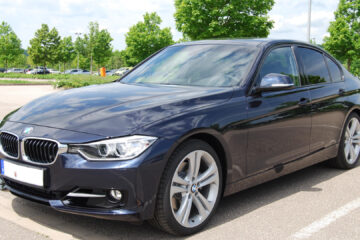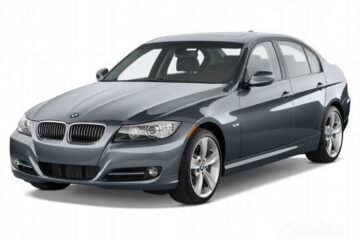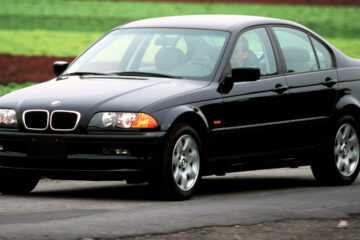BMW 3 Series III E36 has become one of the revolutionary cars, if we consider some indicators. It was the first model to which Bavarian manufacturers “glazed” the head optics. Later, this began to be applied to the E39 and E38 bodies. The new model was introduced in 1990. It was designed to replace the previous E30 model range.
The production of sedan cars was completed in 1998. The model was completely discontinued in 2000, when it was completely ousted from the market by cars in the E46 body. To date, it is quite difficult to find a decent copy, since there are few of them and more than 20 years have passed since the release. However, the shortcomings and problems of the car are simply not noticed when the pleasure and emotions of driving are felt.
Exterior
The Bavarians have put a lot of effort into the design of the car. The front part of the car is devoid of round lights. But in fact they are there, just hidden behind a rectangular cover. The hood reliefs are at a greater distance from each other. Small changes also touched the grille, but it has not lost the corporate style with nostrils. The bumper also remained similar to the previous model and placed the usual molding of black color. The lower part of the bumper has fog lamps.
The shape of the body has received more impetuous outlines, which is an unconditional plus for the car. Wheel arches have received even greater width. The size of the molding was also changed and increased, which positively affected its appearance. A stylish line has been placed at the top of the car. The window trim with the usual chrome materials was eliminated.
The rear of the car has succumbed to the biggest changes. In the previous version of the body, it was severely low. In the E36, the mistake has been corrected. In the trunk lid there is a recess, which gives the impression of a spoiler. But actually it is not there, it is simply formed by the shape of the trunk. Rear lights have become square-shaped, but received halogen filling. On the rear bumper there is a wide molding, and in the lower part there is a protection made of plastic.
The BMW E36 Coupe was a two-door version and differed from the sedan by 8 cm longer front end. The hood also had slightly larger dimensions, and under the windshield there was a grille for ventilation. The trunk lid was somewhat shortened. The car was also distinguished by the presence of a lower and shorter luggage compartment. The wide doors were fitted with frameless glass. The trick of this car was that the windows were lowered in automatic mode while the doors were open, and after they were closed, they were raised and took the correct position in the seals. The window behind the door was mounted on top of the body pillar, which gave it the ability to open slightly.
The cabriolet did not differ in size from the coupe, but to increase the rigidity of the body was used strengthening of the floor and installation of a more powerful windshield frame. The rear panel of the car was also somewhat reinforced. Buyers could get a rigid aluminum roof as an option, when installed, the cabriolet did not differ from the BMW E36 sedan.
The dimensions of the BMW E36 hatchback were slightly larger, and were about 4433 millimeters in length with a width of 1698 millimeters. The wheelbase was 2700 millimeters. The height of the car body was 1393 millimeters. At the same time, the designers managed to achieve a rather impressive ground clearance, which was 110 millimeters.
Interior
Compared to the previous model, the interior of the BMW E36 has also undergone very big changes. Moreover, the changes were sharply positive. The front space of the car was characterized by high-quality armchairs upholstered with expensive leather. They provided comfortable movement, as well as a sufficient amount of free space. For rear passengers there was a large sofa trimmed with leather. There was not quite a lot of space there, but enough for comfortable movement.
Excellent for its age is the center console, which elegantly connects to the dashboard of the BMW E36 with an air deflector. There are no special details to pay close attention to in the cabin. The standard stereo can only play cassettes, so nobody uses it now, but it looks quite beautiful and attractive. Control of the climate control system is extremely simple. It is carried out with the help of usual washers. One of the washers sets the tempo, the second one sets the temperature, and the third one regulates the air direction. In the lower part there is a place for transportation of audio cassettes.
The tunnel greets the car owners with a cigarette lighter. In the middle there is a gearbox selector, which looks quite interesting. Near the gearshift knob there are the power window keys, and under it there is a button for activating the emergency alarm.
Not only the dimensions of the bodywork depend on the design, but also the stuffing in the interior. In the cabriolet you can find a powerful air conditioning and heating system, which works in automatic mode. It allows to provide maximum comfort during driving with the raised and lowered roof. As an option it is possible to order installation of heated seats. On request, this car can be equipped with a translucent curtain behind the rear backrests. This ensures minimal blowing of passengers when driving at high speeds with the roof down. Useful space of the luggage compartment was 230 liters.
Despite the fact that the Compact (hatchback) body is shortened by 23 centimeters, the long wheelbase allowed to provide one of the largest saloons among cars of its class. As an additional option it was possible to order a version equipped with a soft folding top. There were no changes in the interior design. Usable trunk space was 300 liters, but if necessary, it was possible to fold down the backs of the rear seats, which allowed to get 1030 liters of volume.
Body version Touring, aka station wagon, was distinguished by a large size of the luggage compartment, which amounted to 370 liters. By folding the backrests of the rear sofa you could easily get up to 1320 liters of free space. There was a possibility of folding backrests in parts, which made it possible to provide the most comfortable organization in the placement of cargo and passengers. The luggage compartment itself could be closed with a special curtain, and for reliable fixation of cargo in it there were special hooks.
Motors
In cars of this lineup there was a wide range of gasoline engines BMW E36 with four and six cylinders, the working volume of which ranged from 1.6 to 3.2 liters. Their maximum power ranged from 82 to 325 horsepower. There were also diesel power units, with displacement from 1.7 to 2.5 liters, with peak power from 90 to 143 horses. The first model was the BMW E36 1.6 with the M43B16 four-cylinder engine, providing about 102 horsepower of maximum output. This was the BMW E36 316i model. The same powertrain was installed in the 316g version, which was powered by natural gas. The working volume of the power unit was 1.6 liters.
The BMW 1.8 E36 M43B18 engine was installed on the BMW 318i e36 modification, which received a 1.8 liter displacement that allowed it to develop up to 118 horsepower of maximum power. BMW E36 1.8 was not very popular, as the motor did not provide enough power. On the modification BMW 320i E36 was provided installation of a power unit M50B20 on six cylinders and with 24 valves. Specifications of BMW E36 with such a motor provided for a working volume of 1.9 liters. This allowed to provide a maximum power of 150 horsepower.
Also one of the first modifications was the BMW 325i E36 with the M50B25 engine, located under the hood. The working volume of the power unit was 2.5 liters, which allowed it to develop power up to 192 horsepower. The dynamics of acceleration of these cars left much to be desired, but it was compensated by greater economy. Also notable was the fact that these cars began to develop a greater maximum speed. Tuning of BMW E36 was made by many companies and ateliers.
October 1991 was marked by the start of sales of diesel modification 325td BMW 3 E36 coupe, which was equipped with an additional supercharger in the form of a turbine. This car was equipped with an economical engine M51D25 for 2.5 liters of working volume, developing a power of 143 horsepower. Fuel consumption of this modification of BMW E36 while driving in the city was about 9 liters per 100 km. The same year brought the world and sporty modification 318is. At the Detroit Motor Show in January 1992 was presented Coupe 320i with two doors, under the hood of which there was a 1.9-liter engine with a maximum capacity of 150 horsepower.
The 325i Coupe was also introduced this year. The car was equipped with a 2.5 liter motor that provided 192 horsepower of peak power. In September 1992, the VANOS system began to be installed on the bleed valves of all motors that provided for 6 cylinders. This allowed for lower fuel consumption and more thrust.
In October 1993, the 2.5-liter diesel engine was replaced by a turbocharged M51D25 motor fitted to the 325td version. This powertrain featured high revs and the same displacement, but provided 115 horsepower.
There was also a 325tds model, which was equipped with the same motor, but it provided 143 horses. This was achieved by installing an intercooler. The presence of an intercooler can be determined by the index s in the marking. Thanks to this solution, it was possible to provide the car with a maximum speed of 214 kilometers per hour.
February 1994 also brought the world a new version, which provided for the installation of an economic engine for 4 cylinders. This was the M43B16, which had a displacement of 1.6 liters. The peak power of the power unit was 102 horsepower. Also in the lineup appeared and turbocharged diesel motor M41D17 on 1.7 liters of displacement, providing 90 horsepower of maximum power. The M44B19 was another addition to the lineup. The working volume of the motor was 1.9 liters, and the maximum power indicator – 115 horses. The last in the updated range was a 140 horsepower 1.9 liter M44B19, which differed by the installation of a 16-valve cylinder head.
In August 1994, the range of supercharged diesel engines was extended. To the six-cylinder engine was added a power unit M41D17 for four cylinders, which provided a working volume of 1.7 liters. It was installed under the hood of the 318tds.
January 1995 marked the appearance of the 328i model, which was equipped with the M52B28 power unit with a 2.8 liter displacement providing 193 horsepower.
In May 1995, a modification of 323i Touring was presented, under the hood of which was placed a new in-line six-cylinder power unit M52B25, made of aluminum. The volume of the motor was equal to 2.5 liters and at the same time it could provide maximum power of 170 horsepower. There was also in the lineup and more powerful model 328i Touring, which provided for the installation of the M52B28 engine, capable of providing 193 horsepower. As for the reliability of these engines, the largest number of positive reviews is addressed to all gasoline power units on 6 cylinders, which have a working volume of 2.5 liters. They appealed to owners due to their fantastic sound, long service life and quick response when pressing the accelerator pedal. It is also worth being careful with the motors installed on the 320i versions – they consume a lot of fuel and suffer from lack of power.
But six-cylinder engines also have certain disadvantages. Most of all, owners of cars with such engines are concerned about overheating as a result of radiator failure, as well as a faulty water pump or a crack in the expansion tank. The viscous clutch of the fan does not cause special problems, as it can be repaired independently and the condition can be quickly diagnosed. The idle speed sensor on the BMW E36 M40 with this motor is very often out of order.
The four-cylinder engines have been modernized several times. It is not worth paying attention to the early versions of the M40, as they are characterized by a short service life of the timing belt. M43 motors, which were equipped with a chain drive, are much better. The best in the line of motors for 4 cylinders is considered to be M44, characterized by a cylinder head with 16 valves. This engine was installed on 318is from 1996. Earlier versions were equipped with the M42 motor, which often bothers its owners with oil seals on the camshaft.
Among the three diesel powertrains, the weak diesel is the most reliable. The 2.5-liter motors have persistent problems with the fuel injector and cylinder head.
Features
The gearboxes from the Bavarians have proven themselves on the positive side. But it is necessary to pay attention to oil change after every 20 thousand kilometers and to observe the condition of the oil seals. It is necessary to know which oil and which lubricants with BMW approval are best to use.
Automatic gearboxes provide for the installation of microprocessor control, as well as the presence of switches modes “winter-economy-sport”. It is very rare to find JATCO boxes from the Japanese, as well as GM from the French for four steps. German ZF boxes are the most widespread. It is not difficult to repair such automatic transmissions, as well as to get parts for them.
It is very difficult to call the running gear of the car weak. But it is not without disadvantages, because at fast driving, when there are a lot of passengers in the car, there is a great probability to break the lowest coil on the rear springs. Therefore, drifting on such cars without proper preparation should not be carried out.
Differences between restyling and prerestyling
The year 1997 brought a slight modernization of the exterior of the BMW 316i compact E36 and other body styles. Additional items were added to the range of body colors and upholstery. To the standard equipment added installation of ABS system for cars with gasoline engines for 6 cylinders. Aspherical rearview mirrors received a heating function. The grille and side turn indicators have not remained unchanged.
On BMW E36 M43 cars added the possibility of customization, providing the installation of a new development of the Bavarians – an automated gearbox SMG for six steps. This made it possible to drive the car with an automatic transmission, and if necessary, to switch it to manual mode.
Changes also affected the BMW 3 compact E36, which began to be equipped with the M52B25 engine for 2.5 liters, allowing to develop up to 170 horsepower of maximum power. The model index is 323ti Compact.
The period 1994-2000 was marked by the production of the legendary model. In 2000, it was removed from the assembly line.
Generations and equipment
Station wagon 3rd generation
01.1995 – 05.1999
| 316i MT | M43B16 | 1.6L | 102 hp |
| 318tds MT | M41D17 | 1.7L | 90 hp |
| 318i MT | M43B18 | 1.8L | 115 hp |
| 320i MT | M52B20 | 2.0L | 150 hp |
| 323i MT | M52B25 | 2.5L | 170 hp |
| 325tds MT | M51D25 | 2.5l | 143 hp |
| 328i MT | M52B28 | 2.8L | 193 hp |
Hatchback 3rd generation
04.1994 – 09.2000
| 316i MT | M43B16 | 1.6L | 102 hp |
| 318tds MT | M41D17 | 1.7L | 90 hp |
| 316i MT | M43B19TÜ | 1.9l | 105 hp |
| 323i MT | M52B25 | 2.5L | 170 hp |
Convertible 3rd generation
04.1993 – 04.1999
| 318i MT | M43B18 | 1.8L | 115 hp |
| 320i MT | M52B20 | 2.0L | 150 hp |
| 320i MT | M50B20 | 2.0L | 150 hp |
| 325i MT | M50B25 | 2.5L | 192 hp |
| 328i MT | M52B28 | 2.8L | 193 hp |
Coupe 3rd generation
03.1992 – 04.1999
| 316i MT | M43B16 | 1.6L | 102 hp |
| 320i MT | M52B20 | 2.0L | 150 hp |
| 320i MT | M50B20 | 2.0L | 150 hp |
| 323i MT | M52B25 | 2.5L | 170 hp |
| 325i MT | M50B25 | 2.5L | 192 hp |
| 328i MT | M52B28 | 2.8L | 193 hp |
Sedan 3rd generation
10.1990 – 02.1998
| 316i MT | M40B16 | 1.6L | 99 hp |
| 316i MT | M43B16 | 1.6L | 102 hp |
| 318tds MT | M41D17 | 1.7L | 90 hp |
| 318i MT | M40B18 | 1.8L | 113 hp |
| 318i MT | M43B18 | 1.8L | 115 hp |
| 320i MT | M52B20 | 2.0L | 150 hp |
| 320i MT | M50B20 | 2.0L | 150 hp |
| 323i MT | M52B25 | 2.5L | 170 hp |
| 325i MT | M50B25 | 2.5L | 192 hp |
| 325td MT | M51D25 | 2.5L | 115 hp |
| 325tds MT | M51D25 | 2.5l | 143 hp |
| 328i MT | M52B28 | 2.8L | 193 hp |



0 Comments